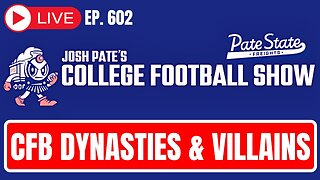Premium Only Content

What is Precision-Scheduled Railroading?
In the past, railroads would focus on moving trains rather than rail cars. There would be long trains to maximize cargo capacity. Trains were operated as either unit trains, that moved a single commodity, or manifest service, which carried several types of cargo. Unit trains were preferred because they were faster. If a train wasn’t long enough, it would be cancelled because it did not meet a length requirement and the customer had to wait another day for train service. The focus on trains was slowing down the network and caused train cars to sit for long periods of time. Slower rail network velocity, or train speed, means it takes longer for train equipment to return to its owner. This results in more unproductive train cars.
Precision-scheduled railroading, or PSR, puts the focus on moving train cars by keeping trains continuously moving regardless of train length. PSR involves operating trains on fixed schedules rather than waiting for cargo. This reduces wait times and increases reliability. As trains continually move through the network, the network becomes more balanced in regards to resources like crews, cars, and locomotives. PSR is a management system designed to improve service, make operations more efficient and cut costs by sticking to a preset schedule. PSR involves the optimizing of train movements, cargo, and personal.
The principles of PSR can be summarized as:
Optimization of assets such as locomotives and railcars.
Eliminate inefficiencies such as excess capacity to reduce costs.
Prioritize traffic flow to reduce bottlenecks and increase speed.
Investment in technology and data analytics to optimize train movements and identify bottlenecks.
With PSR, equipment spends less time in rail yards, fewer trains run on routes, train cars are heavier and packed with more cargo, and the need for locomotives is lessened. Some locomotives can even be taken out of service. There is also less workforce needed. In 2011, there were 159,000 railroad employees at the seven largest freigt railroads in North America. In 2021, there were 115,000 employees representing a 28% drop in a period where freight fell by only 11%. Railroads have been able to increase revenue per ton of freight.
There has not been a clear link between PSR and accident rates established yet but the system certainly introduces new hazards and additional risks.
Works Cited:
https://www.wsj.com/articles/railroads-are-a-lot-more-efficient-are-they-also-less-safe-7c5d2a60?mod=hp_lead_pos5
-
 58:27
58:27
Flyover Conservatives
1 day agoGarrett Ziegler Breaks Down Special Councilor’s Report on Hunter Biden. Insights for Trump’s Top Picks. | FOC Show
71.5K6 -
 44:54
44:54
Steve-O's Wild Ride! Podcast
17 hours ago $11.24 earnedMark Wahlberg Threatened To Beat Up Jackass Cast Member - Wild Ride #251
119K11 -
 1:13:34
1:13:34
Josh Pate's College Football Show
12 hours ago $2.78 earnedCFB Dynasties & Villains | Marcus Freeman OR Ryan Day | 2025 Sleeper Teams | Cole Cubelic Joins
41.6K -
 1:00:26
1:00:26
The StoneZONE with Roger Stone
10 hours agoSHOCKING NEW TAPE PROVES LBJ KILLED JFK! | The StoneZONE w/ Roger Stone
62.2K27 -
 1:44:33
1:44:33
ObaTheGreat
12 hours agoCrypto vs The World w/ Oba The Great And YaBoySkey
46.5K4 -
 4:39:55
4:39:55
VOPUSARADIO
2 days agoPOLITI-SHOCK! "COUNTDOWN TO TRUMP" & THE GLOBALISTS BURNING IT ALL DOWN..LITERALLY!
20.9K1 -
 44:34
44:34
Kimberly Guilfoyle
15 hours agoCountdown to Inauguration Day, Plus California in Crisis, Live with Joel Pollack & Roger Stone | Ep. 189
134K58 -
 1:32:41
1:32:41
Redacted News
14 hours agoBiden's 'SNEAKY' plot to slow down Trump REVEALED | Redacted w Clayton Morris
148K253 -
 56:32
56:32
Candace Show Podcast
14 hours agoOH SNAP! Justin Baldoni Is Now Suing Blake Lively and Ryan Reynolds PERSONALLY | Candace Ep 134
128K216 -
 1:05:38
1:05:38
Havoc
11 hours agoHell on Earth | Stuck Off the Realness Ep. 24
21.2K